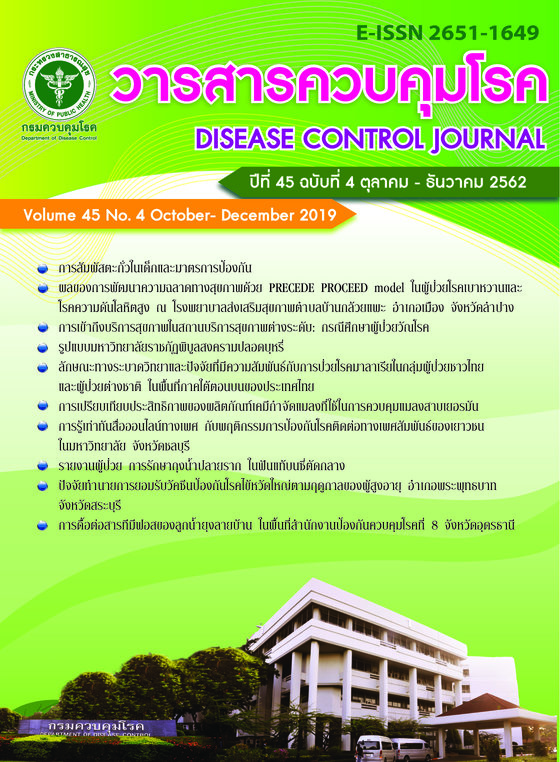The model for being the tobacco-free Pibulsongkram Rajabhat University
DOI:
https://doi.org/10.14456/dcj.2019.34Keywords:
model, smoke-free, Pibulsongkram Rajabhat UniversityAbstract
This current research focused on the smoking situation of university students and created the model for establishing a smoke-free campus in Pibulsongkram Rajabhat University (PSRU). A total of 553 participants were selected as samples. It was found that around 25.0% of respondents had smoked the cigarettes. Most of the respondents had knowledge about cigarettes at a good level (84.6%). Most of the respondents have bad attitudes on smoking at a moderate level (73.1%) and at a high level (24.8%). Respondents have a negative perception about smoking at a moderate level (59.7%), while having perceived self-efficacy at a moderate level (88.4%). Regarding people around the students, close relatives (55.2%), friends (55.0%) and family members (42.0%) of students had smoked the cigarettes. It was found that 21.5% of participants, whose close friends were smoking cigarettes, were smokers. Meanwhile, the percentage of smoking respondents, whose close friends and/or family members were smoking cigarettes, were 16.8% and 16.6%, respectively. In terms of a smoke-free PSRU model, four consideration aspects were as follows: (1) Administrators should come up with clear policy directions and implementation guidelines; (2) Student association should be actively involved in the activities campaigning for the university to be a smoke-free campus; (3) The department of student development should establish a smoking cessation clinic for providing advice and support to those who want to quit smoking; and (4) Lecturers and advisors should educate the students concerning health risks of smoking.
Downloads
References
2. World Health Organization. Monitoring tobacco use and prevention policies. Geneva: World Health Organization; 2017.
3. Boonthong T, Srimaurakot P, Klamphakron S. Health and cigarette: the role of nurses in creating smoke-free Thai society. Chiang Rai: Chiang Rai Rungrot; 2008. (in Thai)
4. Slaughter E, Gersberg RM, Watanabe K, Rudolph J, Stransky C, Novotny TE. Toxicity of cigarette butts, and their chemical components, to marine and freshwater fish. Tob Control 2011;20:25-9.
5. Tiemjai P, Thisara P. Developing of a smoke-free university model by School of Nursing, University of Phayao. Thai J Nurs 2012;61:54-61. (in Thai)
6. Channuan N, Suebsamran P. The situation of smoking behavior among staff and students at Ubon Ratchathani University: smoke free Ubon Ratchathani University project. Journal of Science & Technology, Ubon Ratchathani University 2016;18:1-10. (in Thai)
7. Pichetweerachai W, Sithisarankul P, Hengpraprom S. Prevalence and associated factors of smoking among workers in a university hospital in Thailand. Thammasat Medical Journal 2016;16:396-405. (in Thai)
8. Bundhamcharoen K, Aungkulanon S, Makka N, Shibuya K. Economic burden from smoking related diseases in Thailand. Tob Control 2016;25:532 7.
9. West R. Tobacco smoking: health impact, prevalence, correlates and interventions. Psychol Health 2017;32:1018-36.
10. Charoenca N, Kungsakulniti N, Nitipong V, Hamann SL, Kapa N. A systematic review of study publications related to smoking cessation among Thai adolescents. Journal of Public Health and Development 2017;15:1-15. (in Thai)
11. Sirirassamee T, Sirirassamee B, Borland R, Omar M, Driezen P. Smoking behavior among adolescents in Thailand and Malaysia. Southeast Asian J Trop Med Public Health 2011;42:218-24.
12. Sirirassamee T, Sirirassamee B. Trends in tobacco use among Thai adolescents. J Med Assoc Thail 2013;96:78 84.
13. Ministry of Public Health. The Notification of the Ministry of Public Health (No.19) B.E. 2553 (2010). Re: Designation of the name or type of public space to protect non-smokers from exposure to tobacco smoke and designation of either some parts or all the parts of public space as smoking area or non-smoking area. Government Gazette. No. 127. Section 40 D (March 30, 2010). (in Thai)
14. Reangsing C. Caring for smoking adolescents: a challenging role for nurses. Journal of The Royal Thai Army Nurses 2013;14:17-24. (in Thai)
15. Page RM, Park S, Suwanteerangkul J, Park H, Kemeny M, Philips L. Cross-cultural analysis of cognitive attributions of smoking in Thai and South Korean adolescents. J Sch Health 2012;82:57-64.
16. Daniel WW. Biostatistics: a foundation for analysis in the health sciences. New York: John Wiley & Sons; 1995.
17. Ngamjarus C, Chongsuvivatwong V, McNeil E. n4Studies: sample size calculation for an epidemiological study on a smart device. Siriraj Med J 2016;68:160-70.
18. National Statistical Office. The smoking and drinking behaviour survey 2014. Bangkok: National Statistical Office; 2014. (in Thai)
19. Krungkraipetch L, Krungkraipetch K. Factor affecting smoking behavior of undergraduate students in Burapha University. Burapha Journal of Medicine 2017;4:21-30. (in Thai)
20.Kaewsuwan K, Kalampakorn S. Development of smoke-free community model in Thunghuachang district, Lamphun province. Thai J Nurs 2012;61:54-61. (in Thai)
21. Lee J GL, Goldstein AO, Klein EG, Ranney LM, Carver AM. Assessment of college and university campus tobacco-free policies in North Carolina. J Am Coll Health 2012;60:512-9.
22. Plaspohl SS, Parrillo AV, Vogel R, Tedders S, Epstein A. An assessment of America's tobacco-free colleges and universities. J Am Coll Health 2012;60:162-7.
23. Mamudu HA, Veeranki SP, Kioko DM, Boghozian RK, Littleton MA. Exploring support for 100% college tobacco-free policies and tobacco-free campuses among college tobacco users. J Public Health Manag Pract 2016;22:29–39.
Downloads
Published
How to Cite
Issue
Section
License
Articles published in the Disease Control Journal are considered as academic work, research or analysis of the personal opinion of the authors, not the opinion of the Thailand Department of Disease Control or editorial team. The authors must be responsible for their articles.






